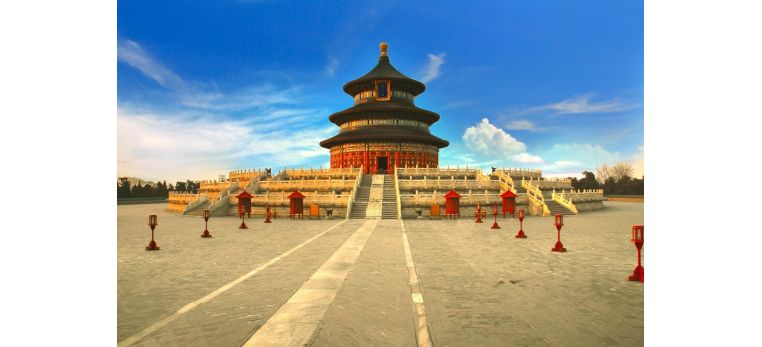
The Temple of Heaven Park, Tiantan in Chinese, is located in the Dongcheng District, Beijing. It is the largest and most representative existing masterpiece among China's ancient sacrificial buildings. Originally, the Temple of Heaven was the place where emperors of the Ming Dynasty (1368 - 1644) and Qing Dynasty (1644 - 1911) held the Heaven Worship Ceremony. First built in 1420, the 18th year of the reign of Emperor Yongle of the Ming Dynasty (1368 - 1644), the Temple of Heaven was enlarged and rebuilt during the reigns of the Ming emperor Jiajing and the Qing emperor Qianlong. In 1988, it was opened to the public as a park, showing ancient philosophy, history and religion. Its grand architectural style and profound cultural connotation give an insight into the practices of the ancient Eastern civilization.
Covering an area of 2,700,000 square meters (3,529,412 square yards), the Temple of Heaven Beijing is larger than the Forbidden City. As the 'Sons of Heaven', Chinese emperors were precluded from building a dwelling for themselves that was greater than the earthly residence dedicated to Heaven hence the difference in overall size of the two complexes. The temple is enclosed by a long wall. The northern part within the wall is semicircular symbolizing the heavens and the southern part is square symbolizing the earth. The northern part is higher than the southern part. This design shows that the heaven is high and the earth is low and the design reflected an ancient Chinese thought of 'the heaven is round and the earth is square'.
Temple of Heaven is divided by two encircling walls into an inner part and outer part. The main buildings lie at the south and north ends of the middle axis of the inner part. The most magnificent buildings are the Circular Mound Altar (Huanqiutan), the Imperial Vault of Heaven (Huangqiongyu) and the Hall of Prayer for Good Harvest (Qiniandian) from south to north.
Divine Music Administration
Located to the southwest of the Palace of Abstinence, the Divine Music Administration is one of the five major buildings in this scenic area. This was the location of the managing body for the ceremonial musical instruments as well as the place where the sacrificial ritual was devised and rehearsed. This was the most important ritual music academy of the Ming and Qing dynasties.
Heaven Worship Culture
Established by Emperor Yongle of the Ming Dynasty, the annual Worship of Heaven ceremony by the emperor took place here. The ceremony was subject to special regulations for its preparation, place, time, procedures, music and dance. This ceremonial practice confirmed the divine right of emperor and the religious belief of the ancient Chinese people.
Today's Temple of Heaven
There are over 60,000 varieties of tree. The most famous tree is the grandfather tree - a 500-year-old Nine-Dragon Cypress with branches like nine dragons winding with each other. These trees create a quiet environment and an ideal resort for the locals to do their morning exercise. Residents living near the this place enjoy many activities here, such as running, cycling, singing, dancing, playing chess, flying kites, etc. You can become involved personally in these activities and experience the leisure pursuits of local people.